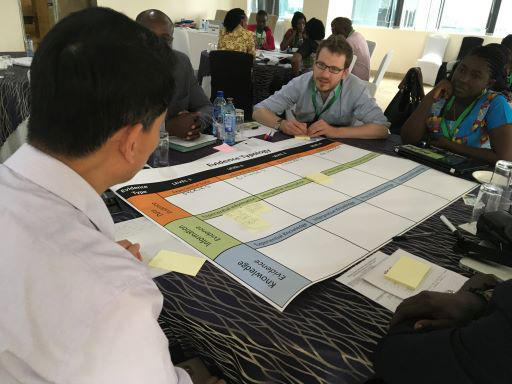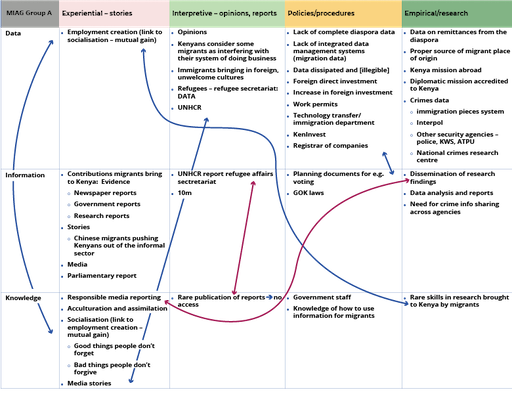5.3 Evidence typology as a discussion object
Another example of a discussion object is the evidence typology which can be seen in Table 5.1. It displays findings from a migration study that the Migration for Inclusive African Growth (MIAG) network completed.
Table 5.1: MIAG migration evidence typology example
Evidence type | Level 1 | Level 2 | Level 3 | Level 4 |
|---|---|---|---|---|
Data evidence | ||||
Experiential observations e.g. local entrepreneurs’ experience of working with a foreign company | Set of discrete facts and messages without meaning e.g. Kenyan policies around migrant flows | Symbols without interpretation, e.g. Kenyan immigration processes for capturing and categorisation of migrant investment | Systematically grouped data that does not answer a specific question e.g. research survey data on Chinese migrant numbers over 10 years | |
Information evidence | Experiential stories information | Interpretive opinion information | Procedural process information | Empirical research information |
Facts organised to describe a condition/situation, e.g. entrepreneurs’ experiences cause more employment of some migrants | Data with related meaning/relevance/ purpose, e.g. Kenya migrant flow policies in the context of changing economic strategy | Processes for meaningful data, e.g. relevance of categorisations for capturing migrant investment | Data that changes perceptions and rigorously answers the questions ‘who, what, where’, e.g. there is a massive increase in Chinese migration to Kenya over 10 years | |
Knowledge evidence | Experiential stories knowledge | Interpretive opinion knowledge | Procedural process knowledge | Empirical research knowledge |
Insights assigned to experiential information, e.g. awareness of entrepreneurs’ experiences, used to change migration investment patterns | Justified beliefs, truths, judgements and know-how, e.g. understanding cause and effects of migrant flow policies in the context of changing economic strategy | Ability to assign further meaning through processes, know-how and methodologies, e.g. new ways of categorising migrant contributions, causes, growth and integration | Valuable information for the human mind that rigorously answers the questions of ‘why’ or ‘how’, e.g. rapid increase in Chinese migration to Kenya due to growing opportunities in Kenya and tightening circumstances in China |
This project used the evidence typology as a discussion object for each group of six to eight stakeholders.

The stakeholders proceeded to fill out the blank discussion object (evidence typology) with support and guidance, helping them to focus on the evidence they knew of in response to the question ‘What contribution do migrants bring to Kenya?
Figure 5.3 is an example of the discussion object completed in Kenya. You will notice that the stakeholders were inspired to include the links between the different types and levels of evidence. The colours added denoted if there was a flow (black) or if there was not a clear flow (red).
Workshop discussion object example
There were many findings from this Evidence Café, but one finding was that the discussion objects (when collated together) had identified that previous discussions had focused on individual areas of expertise; that is, particular stakeholders did not really look outside of their groups for evidence. By contrast, the Evidence Café (and this discussion object) enabled discussions between different areas of expertise. For example, one participant noted:
‘As long as you know there is a gap later on it will help’
Another identified that there is an issue with previous gaps between evidence bases:
‘There is no plan that is based on research’
5.2 Evidence Pyramid as a discussion object

